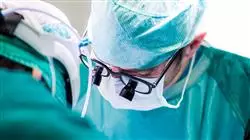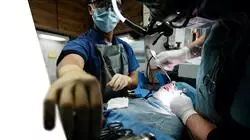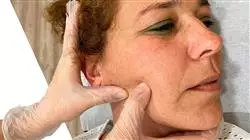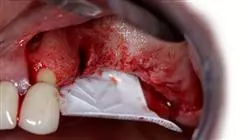University certificate
The world's largest faculty of dentistry”
Description
A 100% online postgraduate diploma with 450 teaching hours of the most advanced and current knowledge on Occlusal and TMJ Dysfunction"

Headaches, joint pain when pressing with the mouth, tooth wear or increased sensitivity are just some of the main symptoms presented by patients with TMJ problems. A correct diagnosis by the dentist, together with technological advances and multidisciplinary work can lead to a really effective treatment.
In this sense, it is essential for professionals to be aware of the scientific studies on these pathologies, as well as on occlusal dysfunction, two fields that generate great concern in the clinical approach. For this reason, this institution has developed this university program of 450 teaching hours with an exhaustive syllabus based on the most notorious advances in this field.
It is, therefore, an intensive program that will lead the specialists to delve into occlusion, classification and management of the different dysfunctions, as well as their study for a correct planning and design of prostheses. A process of updating, which will be much more dynamic thanks to the video summaries of each topic, videos in detail, specialized readings and case studies that students can access, comfortably, whenever and wherever they want.
The professional only needs a computer, tablet or cell phone with an Internet connection to access the content of this program at any time of the day. In this way, without the need to attend a center in person, or have classes with restricted schedules, students can reconcile their daily work and personal activities with a program that is at the academic forefront. Without a doubt, a unique opportunity for updating that can only be offered by TECH, the world's largest online university.
Get an effective update on the different imaging techniques used for the design of prosthetic treatments"
This postgraduate diploma in Occlusal and TMJ Dysfunction contains the most complete and up-to-date scientific program on the market. The most important features include:
- The development of case studies presented by experts in Dental Prosthesis, Implantology and Oral Rehabilitation
- The graphic, schematic and practical contents with which it is conceived
- scientific and practical information on those disciplines that are essential for professional practice
- Practical exercises where the self-assessment process can be carried out to improve learning
- Its special emphasis on innovative methodologies
- Theoretical lessons, questions to the expert, debate forums on controversial topics, and individual reflection assignments
- Content that is accessible from any fixed or portable device with an Internet connection
The most innovative teaching material will allow you to delve into TMJ Biomechanics and boost your diagnostic skills"
The program’s teaching staff includes professionals from the industry who contribute their work experience to this program, as well as renowned specialists from leading societies and prestigious universities.
The multimedia content, developed with the latest educational technology, will provide the professional with situated and contextual learning, i.e., a simulated environment that will provide immersive education programmed to learn in real situations.
The design of this program focuses on Problem Based Learning, by means of which the professional must try to solve the different professional practice situations that arise during the academic course. For this purpose, the students will be assisted by an innovative interactive video system created by renowned and experienced experts.
Delve into the different treatment options for the different conditions of the myoarticular complex"

You will be up to date with the most effective methodologies for analysis, planning and design in prosthetics"
Objectives
One of the main objectives of this educational option is to ensure that the dental professional achieves an effective update on occlusal diseases, their approach, as well as the incorporation of the latest assessment and therapeutic techniques. To this end, TECH provides the graduate with numerous innovative teaching materials that offer a theoretical-practical perspective and are very useful for their regular clinical practice. In this way, they will be able to keep abreast of the most relevant advances and recent scientific evidence.

Get a real and practical vision of prosthetic design through the clinical cases provided by the teaching team of this postgraduate diploma"
General Objectives
- Develop your knowledge of anatomy, physiology and orofacial pathology in order to make accurate diagnoses and design appropriate treatment plans
- Develop skills in the performance of clinical examinations and interpretation of data for an accurate diagnosis and optimal treatment plan
- Update knowledge in the use of dental materials, clinical and laboratory techniques in the design of prostheses with high physiological and aesthetic performance
- Acquire knowledge in the prevention and treatment of complications related to dental prosthetics and occlusion
- Understand the importance of interdisciplinary collaboration for the achievement of ideal results
- In-depth knowledge of the latest clinical and digital trends in the field of oral rehabilitation
Specific Objectives
Module 1. Diagnosis, Planning and Design of Prosthesis
- Delve into the importance of clinical history and anamnesis in the assessment of the patient for the design of prosthetic treatment
- Systematically collect and document relevant patient information
- Delve into the different imaging techniques used in the assessment of patients for the design of the prosthetic treatment
- Describe how to interpret and use the information obtained from imaging tests for treatment planning
- Investigate the prosthetic diagnostic process and the tools and techniques used in this process
- Formulate a definitive diagnosis and establish an appropriate treatment plan
- Select the appropriate type of prosthetic rehabilitation for each clinical case
- Detect the therapeutic variables to be taken into account in prosthetic treatment planning and design an appropriate treatment plan
Module 2. Occlusion
- Delve into the concept and classification of occlusion, as well as the different types of occlusion: physiological, pathological and therapeutic
- Recognize the importance of dental and oral anatomy in occlusion and how it affects in conventional and implant prostheses
- Identify the reference position in occlusion, including habitual position versus centric relation, and learn about the materials and techniques of recording centric relation in dentate, partially dentate, edentulous and dysfunctional patients
- Update the concept of vertical dimension and recording techniques, as well as to know when the vertical dimension can be varied
- Describe the different occlusal schemes, including bibalanced, group and organic function, and understand ideal occlusion and the biological and biomechanical advantages of organic occlusion
- Identify disocclusion factors, such as individual anatomical factors, condylar trajectory, Bennet angle, overbite, overjet, disocclusion angle, Spee and Wilson curves
- Delve into the differences between tripoidism and cusp/fossa in posterior occlusion
- Update knowledge on the use of the articulator in daily practice, including the choice of the ideal articulator, the usefulness and handling of the facebow, reference planes, mounting on the semiadjustable articulator and techniques to reproduce
- the disocclusion angle in an articulator
- Delve into the concept of occlusal disease and learn to recognize clinical examples
Module 3. TMJ. TMJ Anatomy, Physiology and Dysfunction
- Delve into the anatomy of the temporomandibular joint (TMJ), as well as the definition of its dysfunction, etiology and prevalence of disorders that can affect it
- Identify the signs and symptoms of joint disease in the TMJ,
- which will allow a proper diagnosis to be made
- Recognize the importance of TMJ dysfunction in daily practice, as it can affect the quality of life of patients and their ability to perform daily activities
- Delve into the biomechanics of the TMJ to understand how the joint functions occur and how disorders can occur in it
- Classify the different dysfunctions that can affect the TMJ, that will allow identification and differentiation of the different types of disorders
- Identify the muscle disorders that can affect the TMJ, including local myalgia and myofascial pain
- Assimilate the different types of TMJ dislocation

Update your therapeutic knowledge of the different conditions of the myoarticular complex in only 6 months"
Postgraduate Diploma in Occlusion and TMJ Dysfunction.
Occlusion and TMJ (Temporomandibular Joint) dysfunction is a disorder that occurs when there is a problem with the way the upper and lower teeth meet each other and how the temporomandibular joint, which connects the jaw to the skull, functions. This dysfunction can affect a person's ability to chew, speak, yawn and make other common jaw movements. At TECH Global University we have this specialized program designed with the goal of providing the knowledge and skills necessary to effectively diagnose and treat occlusion and temporomandibular joint disorders, which can improve patients' quality of life and reduce their pain and dysfunction.
The cause of occlusion and TMJ dysfunction can vary, but some common causes include teeth grinding, a bad bite, arthritis in the temporomandibular joint, facial trauma, muscle imbalances and stress. As a Postgraduate Diploma you will learn about diagnosis and evaluation of occlusion and TMJ disorders. This is an excellent choice for those who wish to acquire specialized skills and develop a successful career in this field.







